From Ivory Tower to Common Ground
At Virginia Tech, landscape architects are updating the landscape toolkit to create spaces and paths of travel that invite everyone to move freely, together
 Sasaki
Sasaki
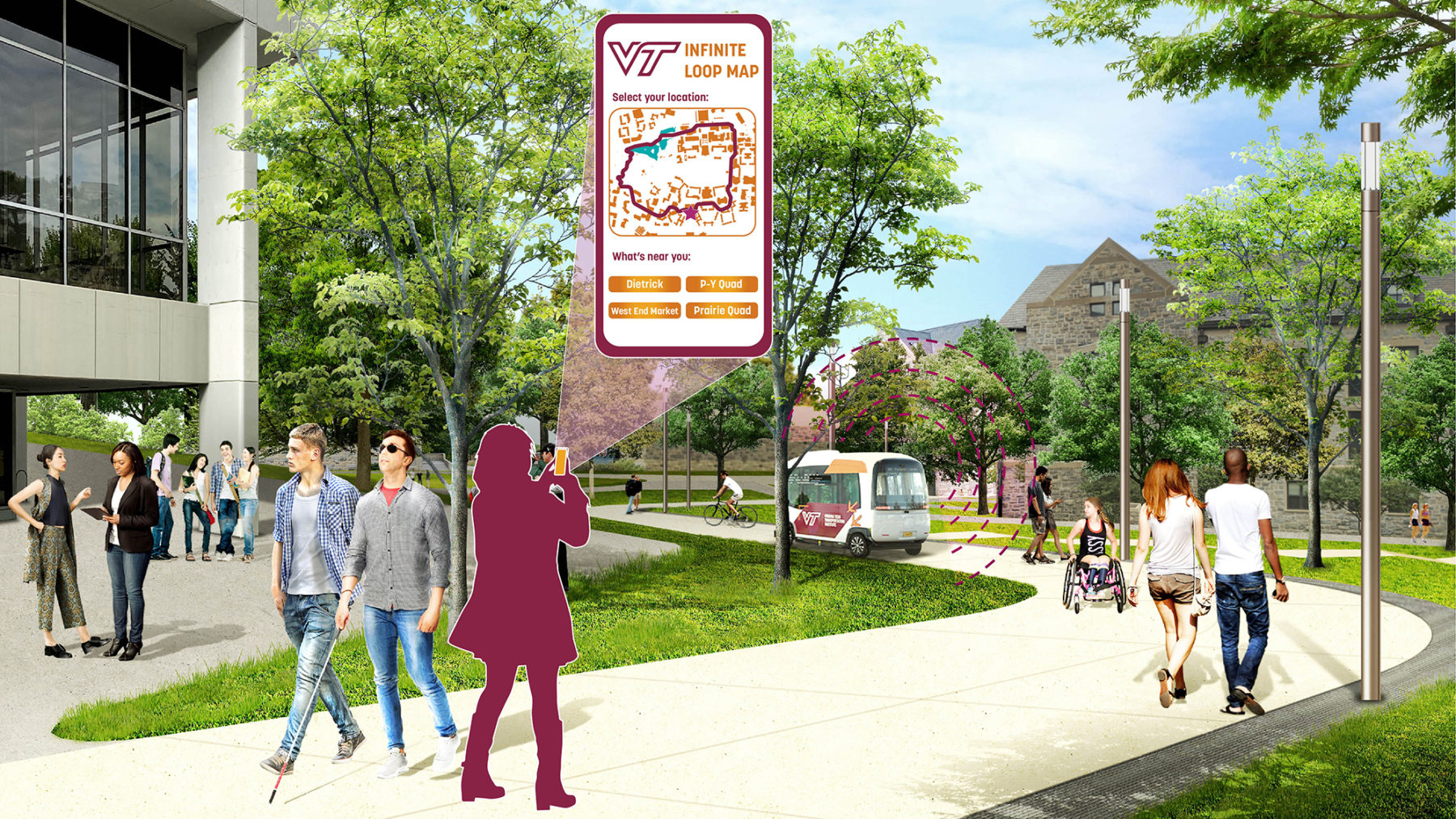
The Infinite Loop and Green Links envision a more equitable and inclusive campus environment by removing over 400 stairs from the campus and replacing them with new universally designed pathways and open spaces
The Infinite Loop and Green Links are a response to the Virginia Tech’s location in the Appalachian Mountains.
These projects catalogue Virginia Tech’s vast network of non-compliant pathways, stairs, and missing links that have not been upgraded since the Americans with Disabilities Act (ADA) was ratified over 30 years ago. Additionally, the projects consider current and future modes of transportation (including autonomous vehicles) in order to envision a future where all mobility modes harmoniously coexist. This amounts to a near-complete retrofit of the core campus landscape, thus implementing the master plan and ushering in a more equitable and inclusive future.
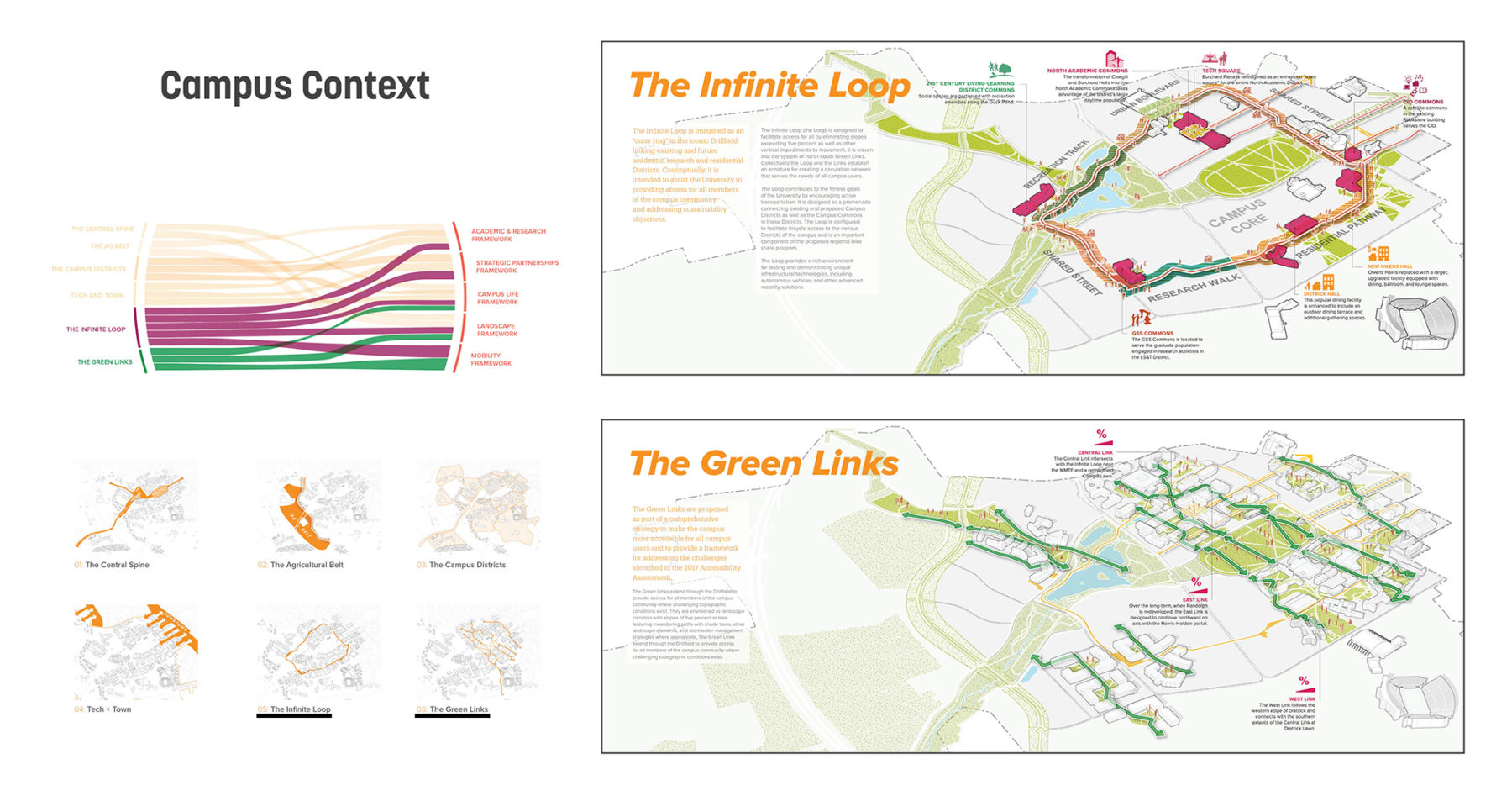
The Infinite Loop is a 2.1-mile barrier-free corridor that connects multiple districts and open spaces
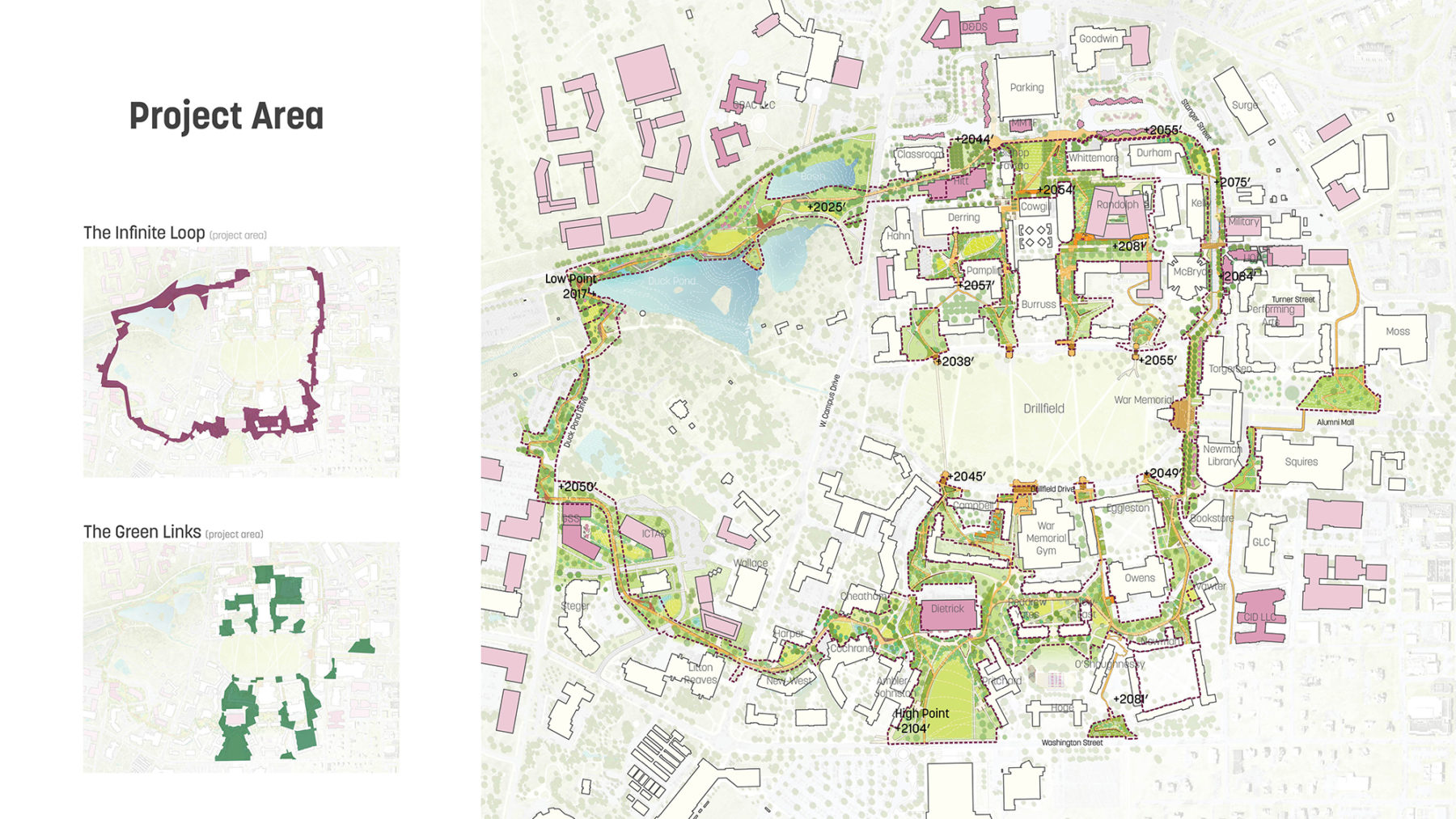
The Green Links are a 3.5-mile network of barrier-free paths that unlock new accessible routes across campus
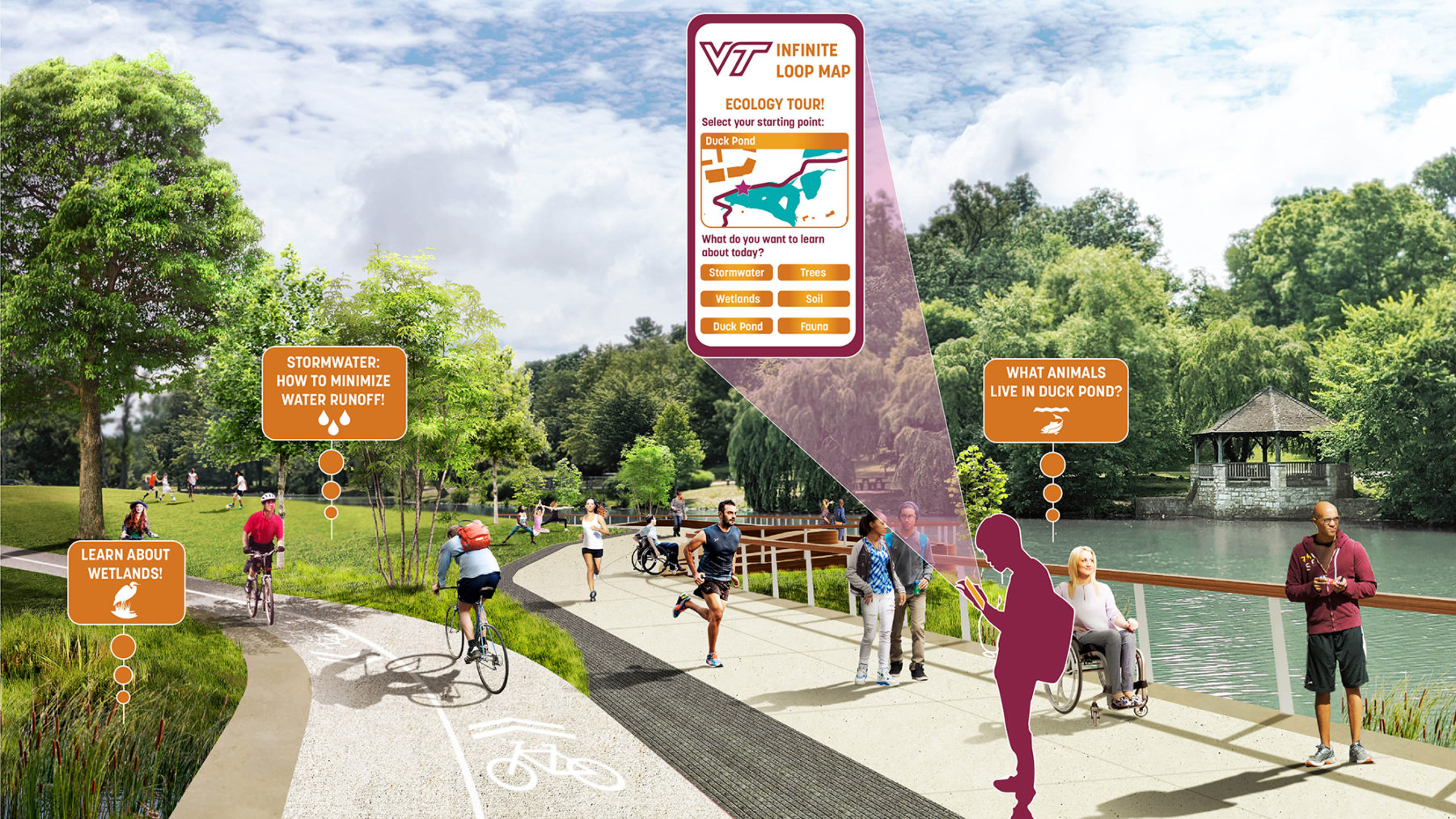
The Infinite Loop and Green Links promote physical and ecological wellness while providing a diverse planting palette that contributes to campus biodiversity
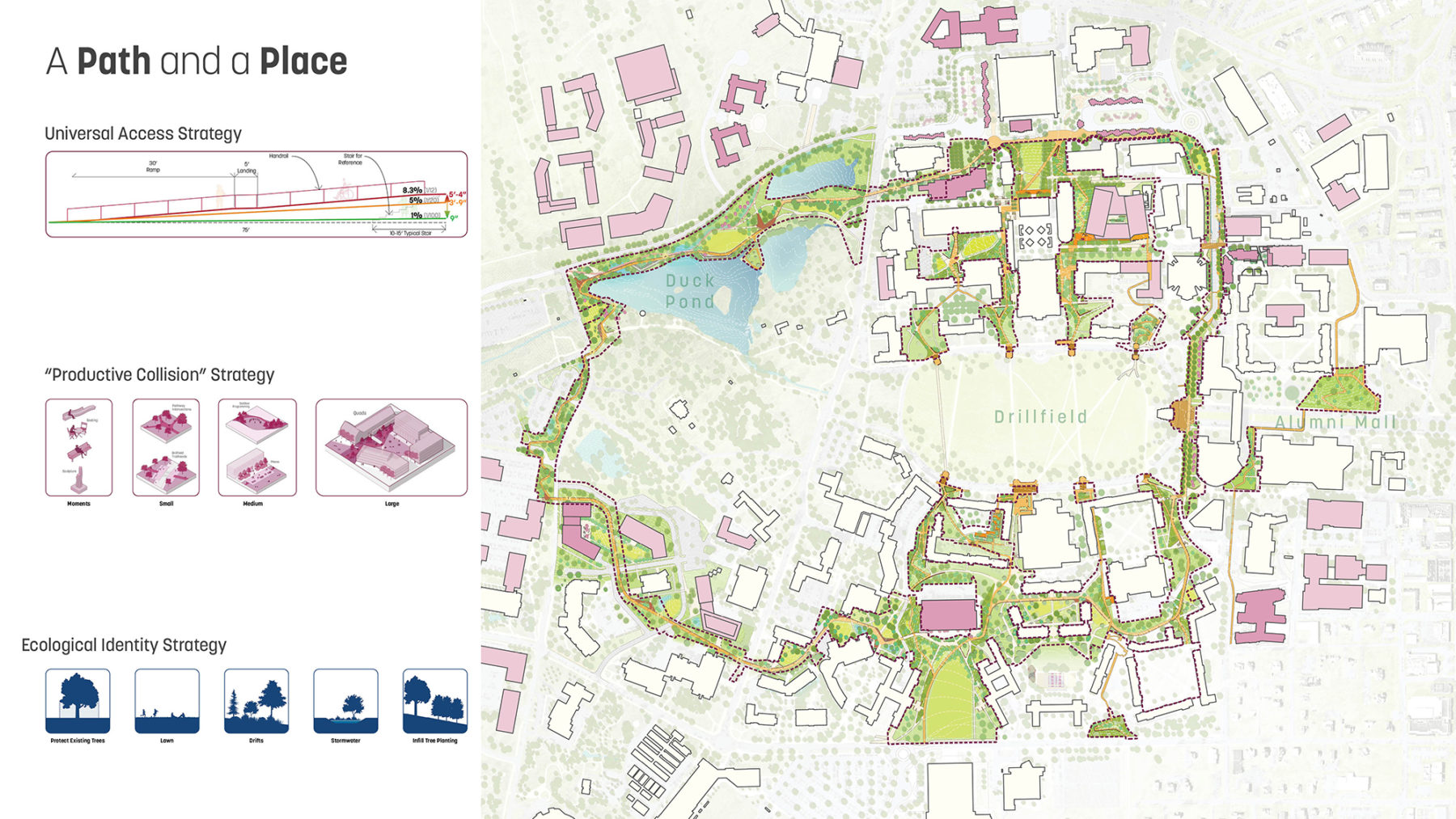
The Infinite Loop and Green Links embody path and place by creating campus-wide strategies for universal access, programming (also known as “Productive Collisions”), and ecological identity
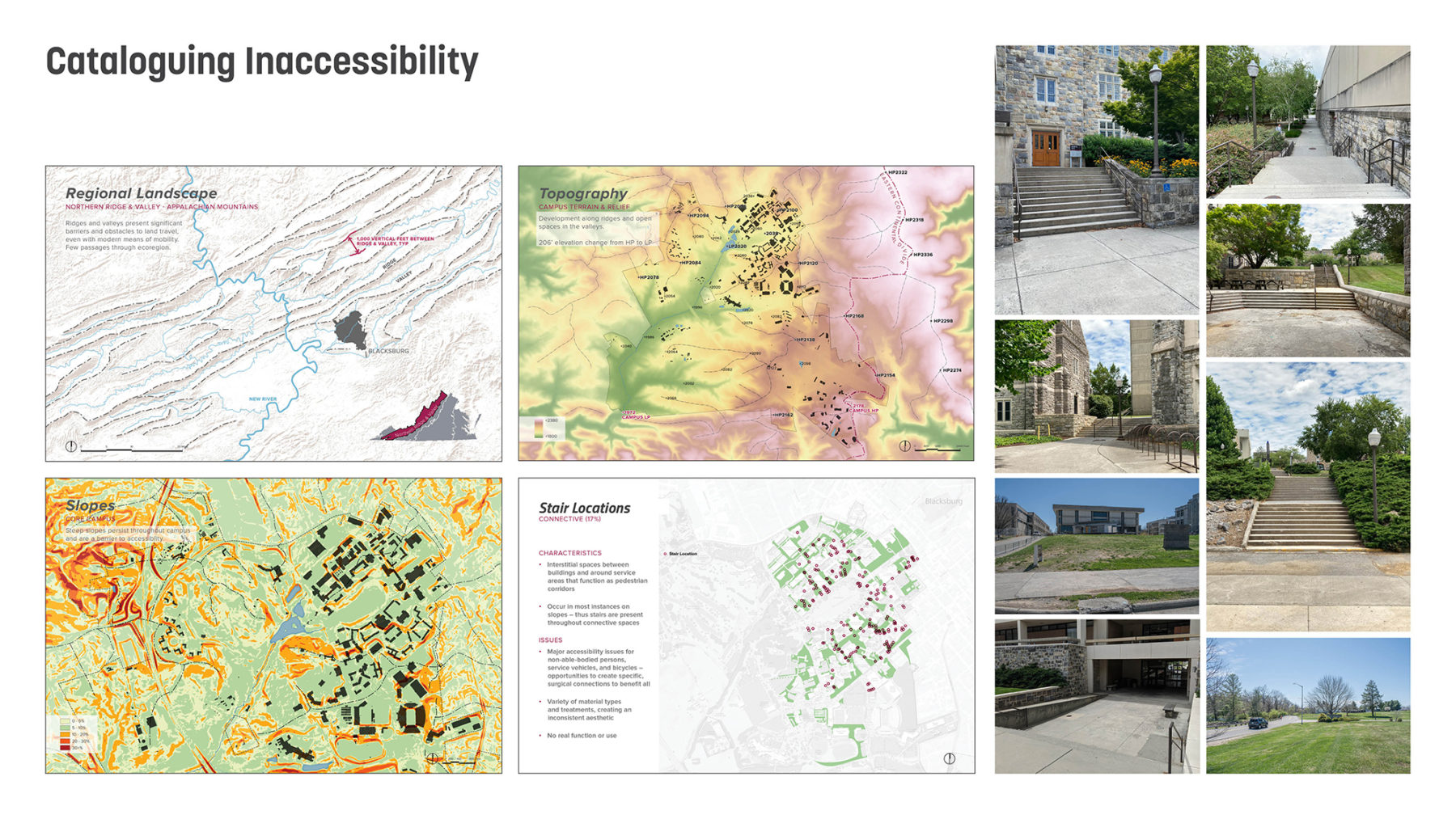
Virginia Tech is a product of it’s Appalachian Mountain location
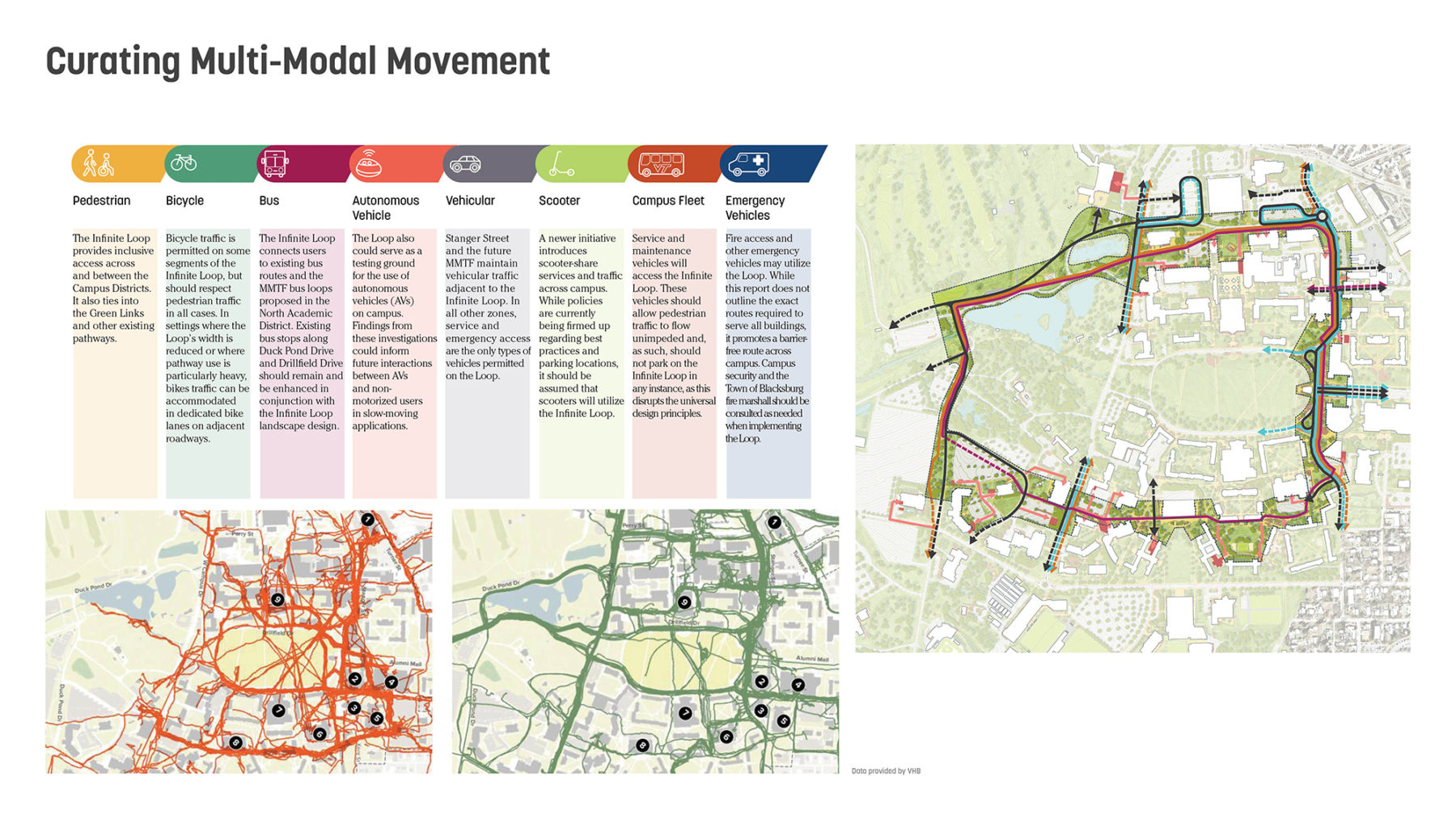
All mobility modes are considered, informed by previous mobility studies
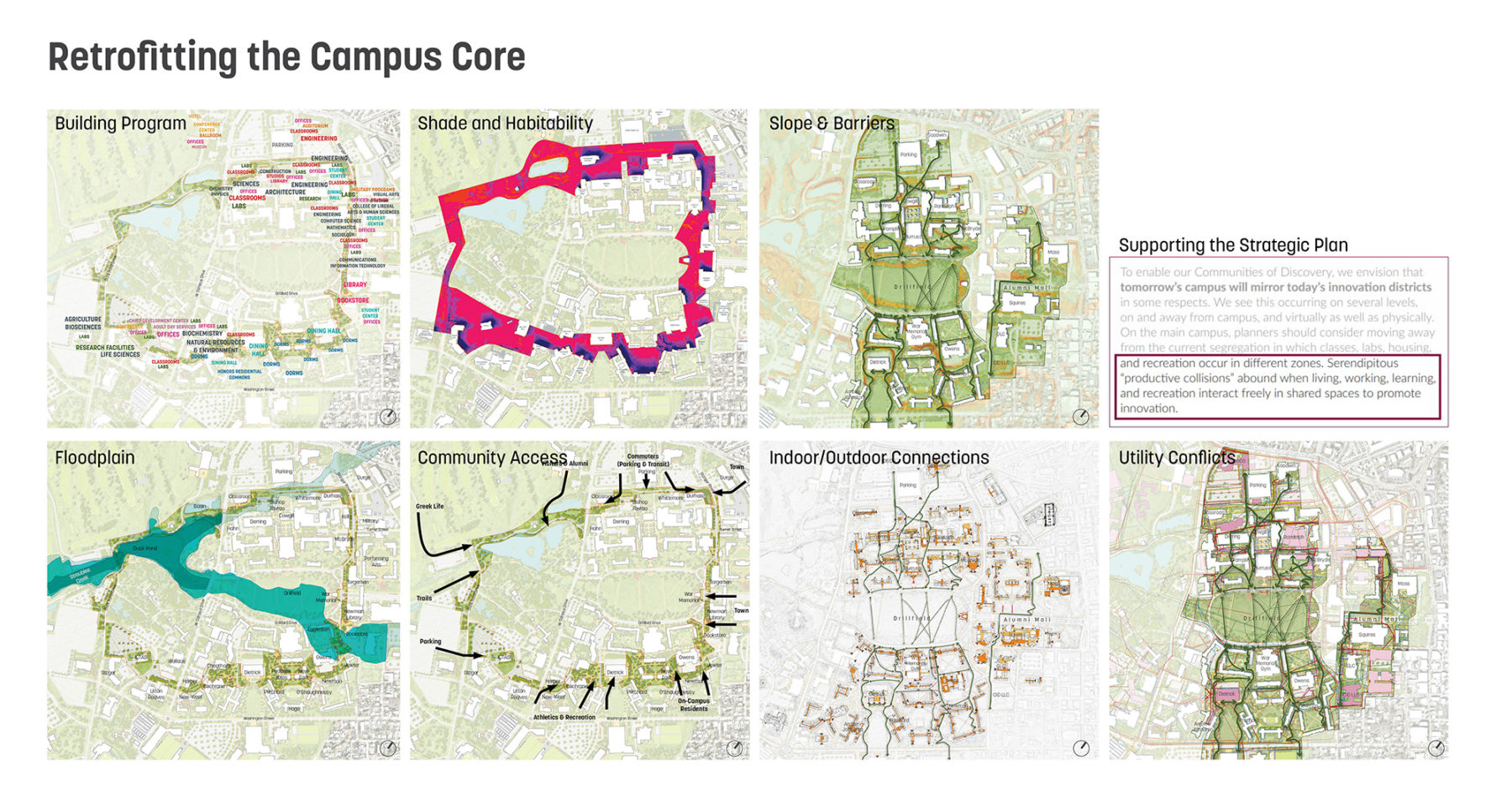
Analyzing the campus to make new landscapes seamless and integrated
The Green Links and the Infinite Loop are built on a strong relationship between the university and the design team. With the strategic plan and master plan as their guide, these projects touch almost every square foot of Virginia Tech’s core campus, weaving through the academic, residential, and ecological districts. To successfully address the needs of various campus conditions, the design team worked closely with the university to assemble four multi-disciplinary advisory groups composed of a diverse range of campus representatives. Monthly Zoom meetings with these groups proved successful in serving as the primary touch points to guide the project while one in-person socially-distanced presentation and site tour served as a check on the draft design. Top priorities include promoting universal design and bringing to life the strategic plan’s charge of creating “productive collisions” moments across campus. A critical outcome of the process is a phased implementation strategy that prioritizes each segment of the plan based on synergies with other capital project timelines, cost, and complexity. Ultimately, the Loop and the Links provide a transformative vision for Virginia Tech that achieves bold goals of universal access while also unifying the campus through new landscape interventions.
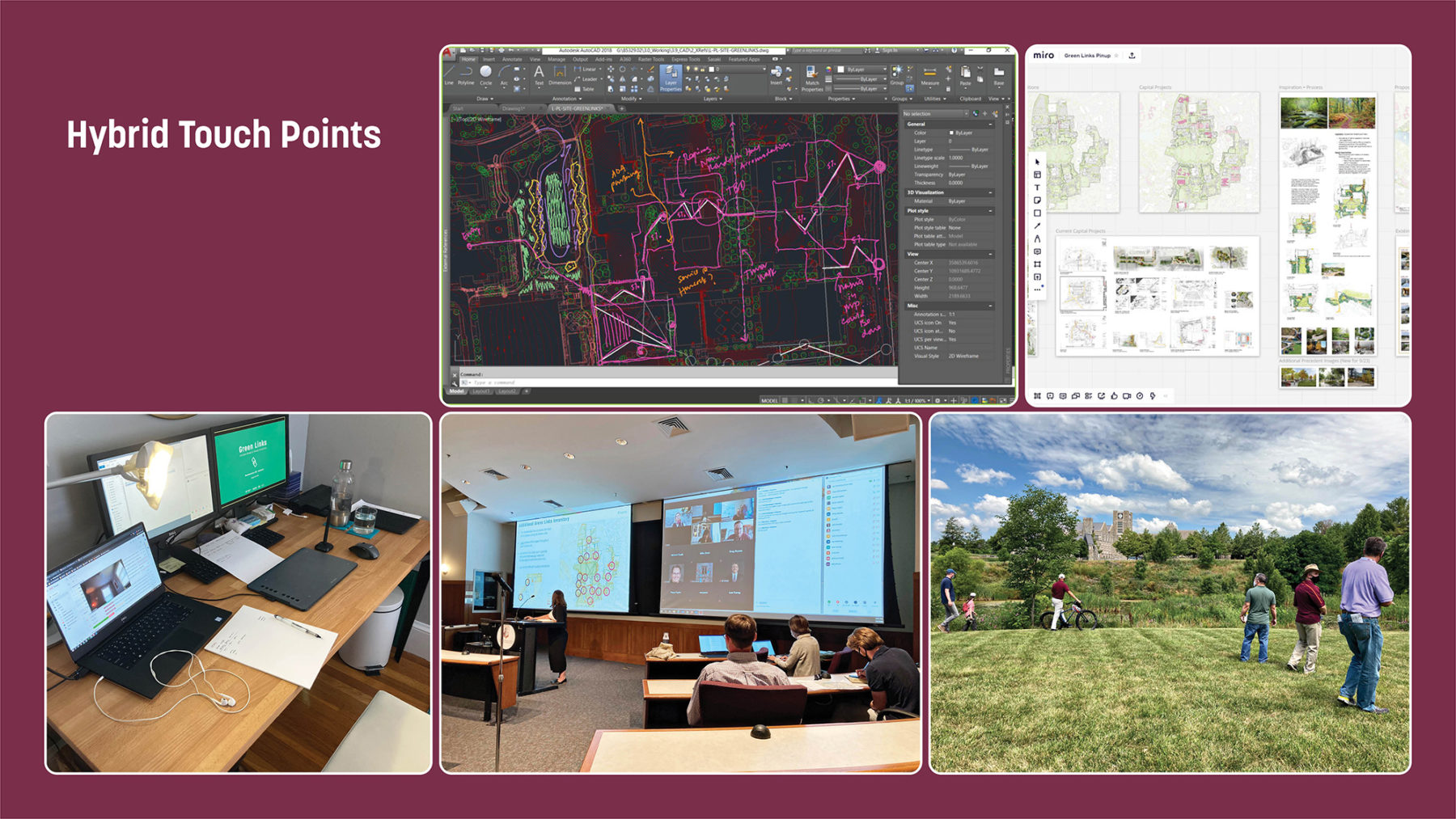
The design team and client collaborated creatively during the pandemic
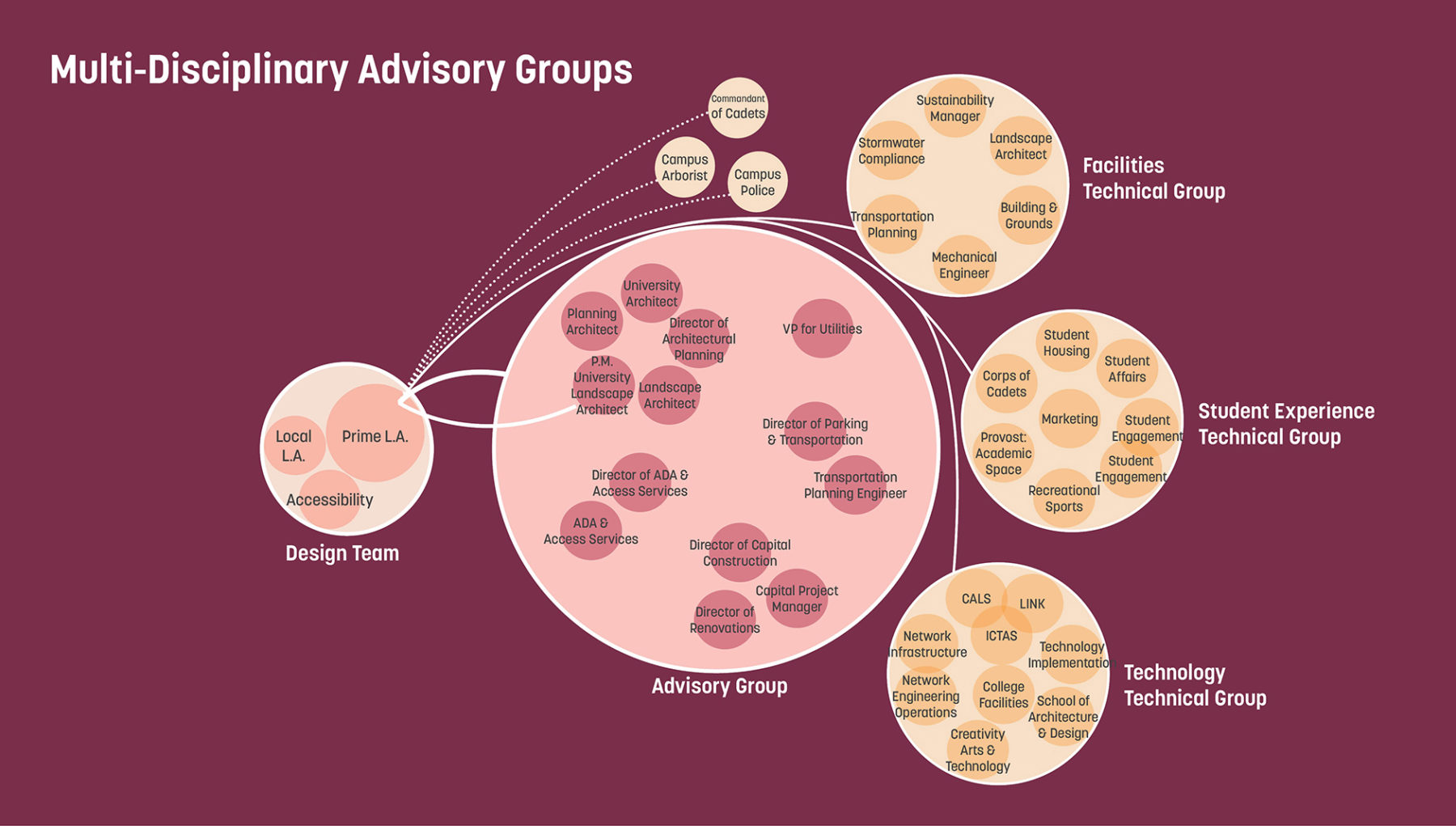
University departments modeled “Productive Collisions” goals during the engagement process
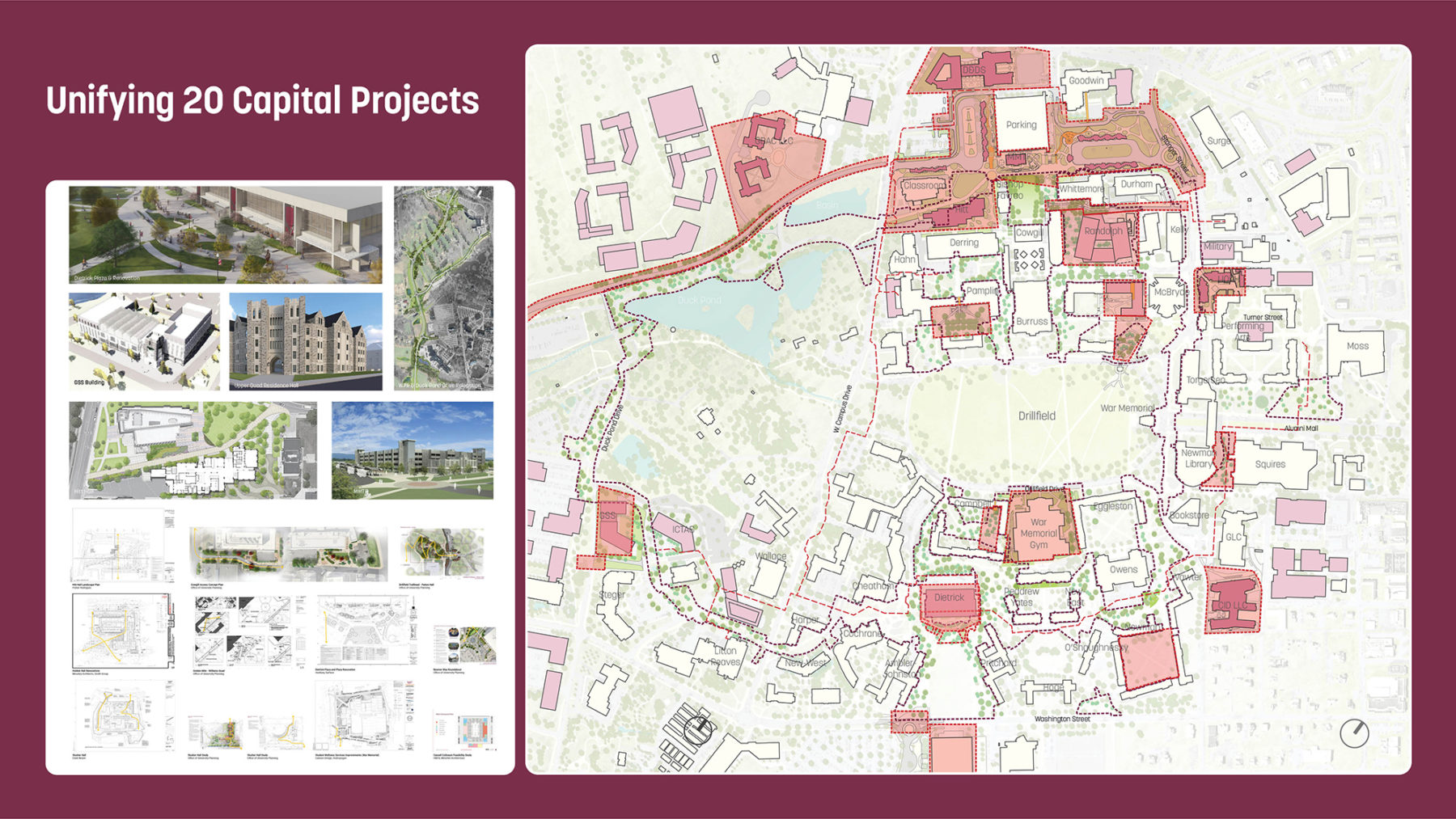
The Loop and Links adapt to ongoing Capital Projects
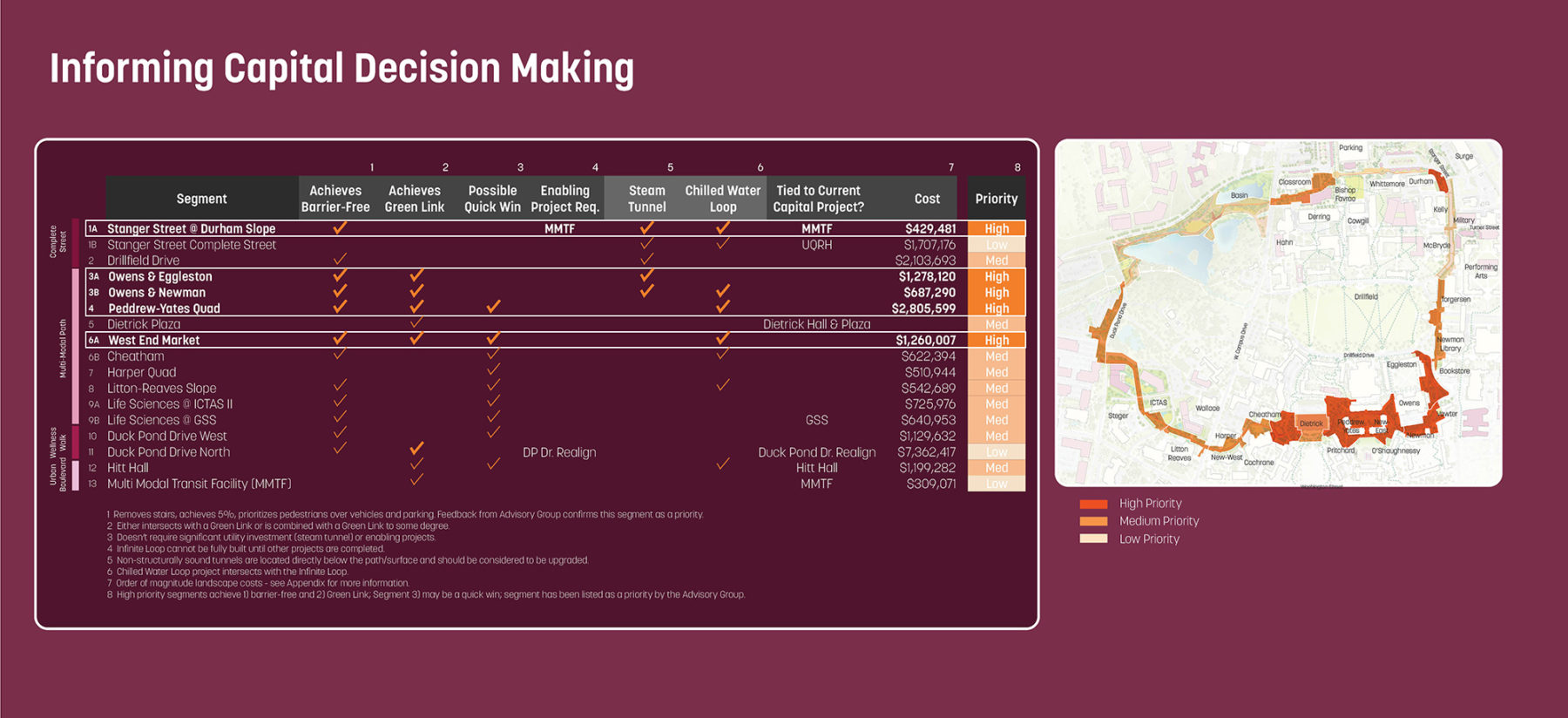
Phased implementation organizes the master plan into implementable projects
The Infinite Loop and Green Links provide Virginia Tech with a detailed concept design for over five miles of campus pathways and open spaces that consider a core campus constituent, the disabled community. These projects embody the university motto, “That I May Serve,” and offer a future where the primary path of travel across campus will always be barrier-free. The design takes direction from the master plan and strategic plan while analyzing the current campus condition and providing detailed landscape strategies that prioritize accessibility, placemaking, and planting. In addition, each project outlines a set of design guidelines that provide direction on what paving materials, site furnishings, lighting, and planting palettes to specify. Each concept contains a robust design narrative and is packaged into a graphic report that provides the Office of University Planning that can be used as a marketing and fundraising tool to help spur implementation.
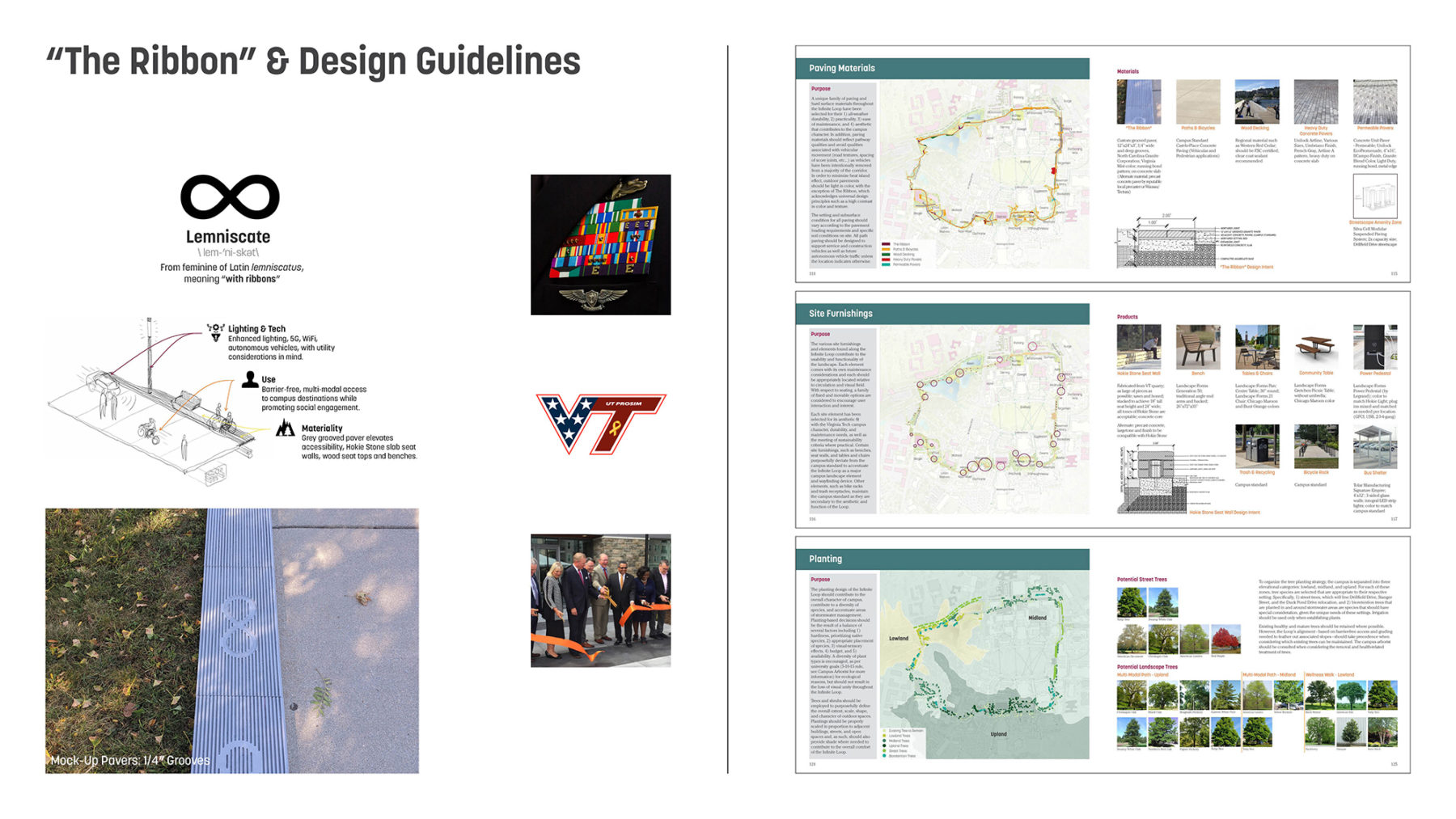
Site design guidelines take inspiration from Virginia Tech’s school identity
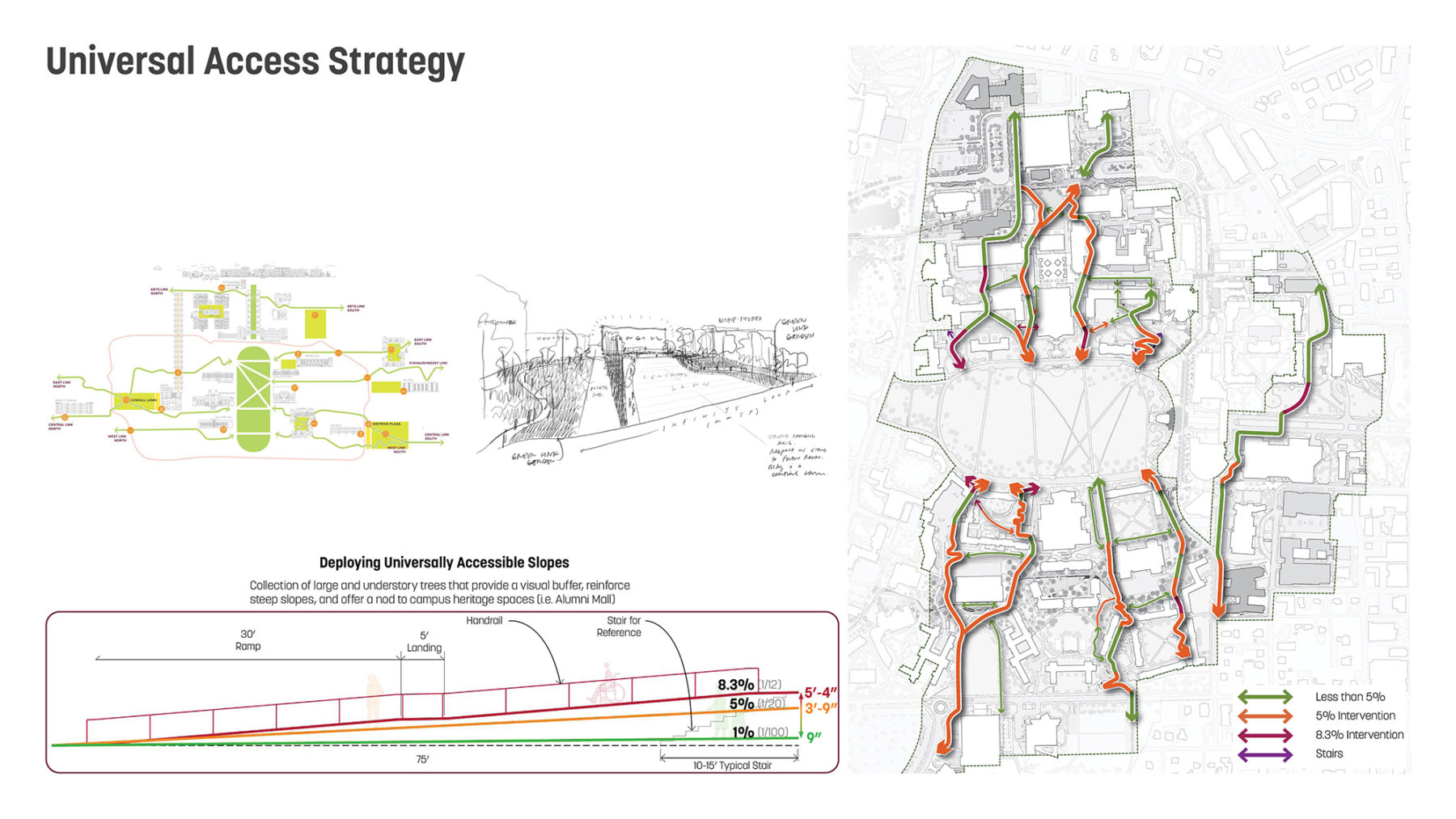
Achieving universal accessibility throughout campus is a primary design goal
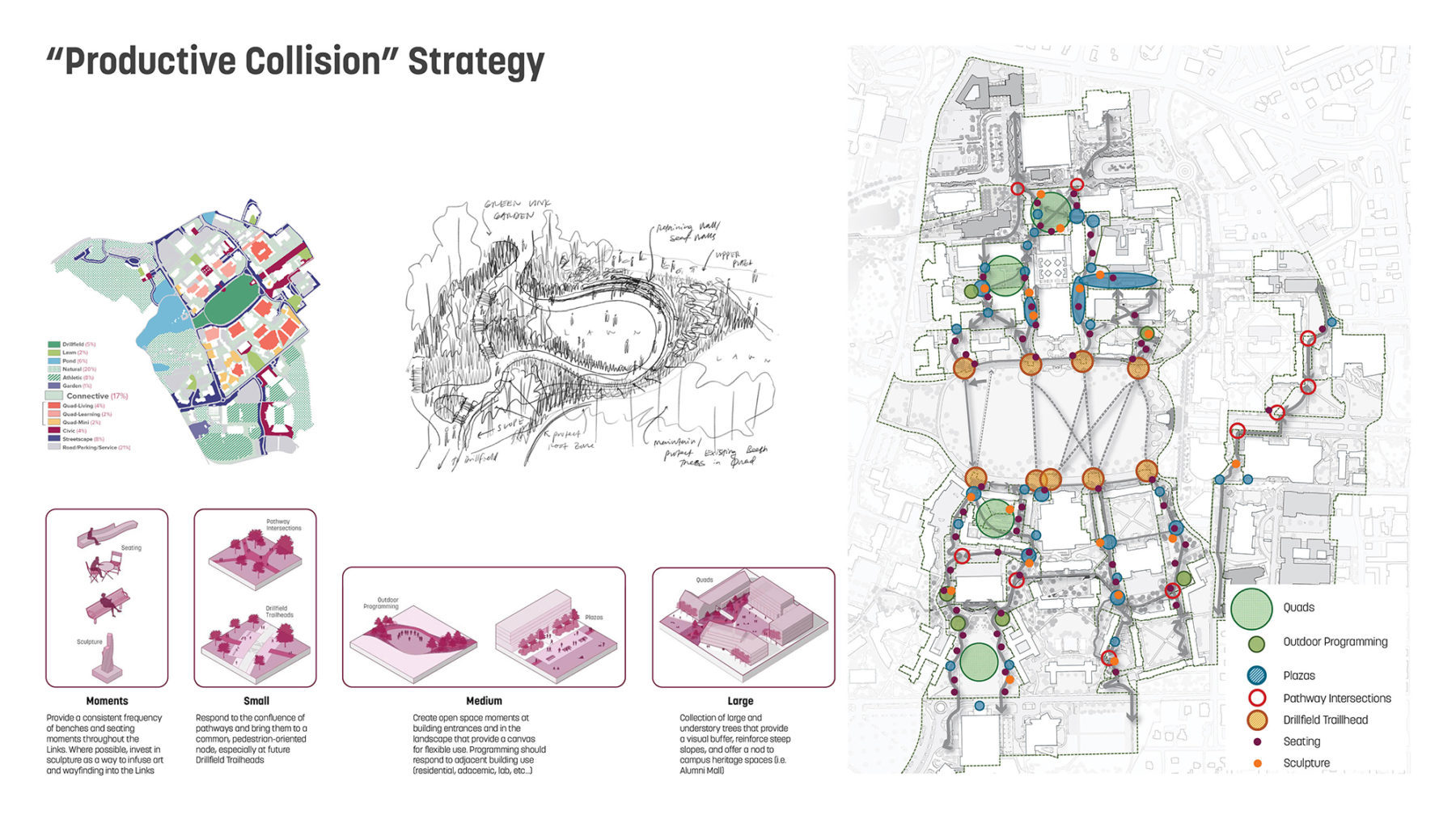
Redesign of quadrangles and pathways encourages outdoor meeting and gathering
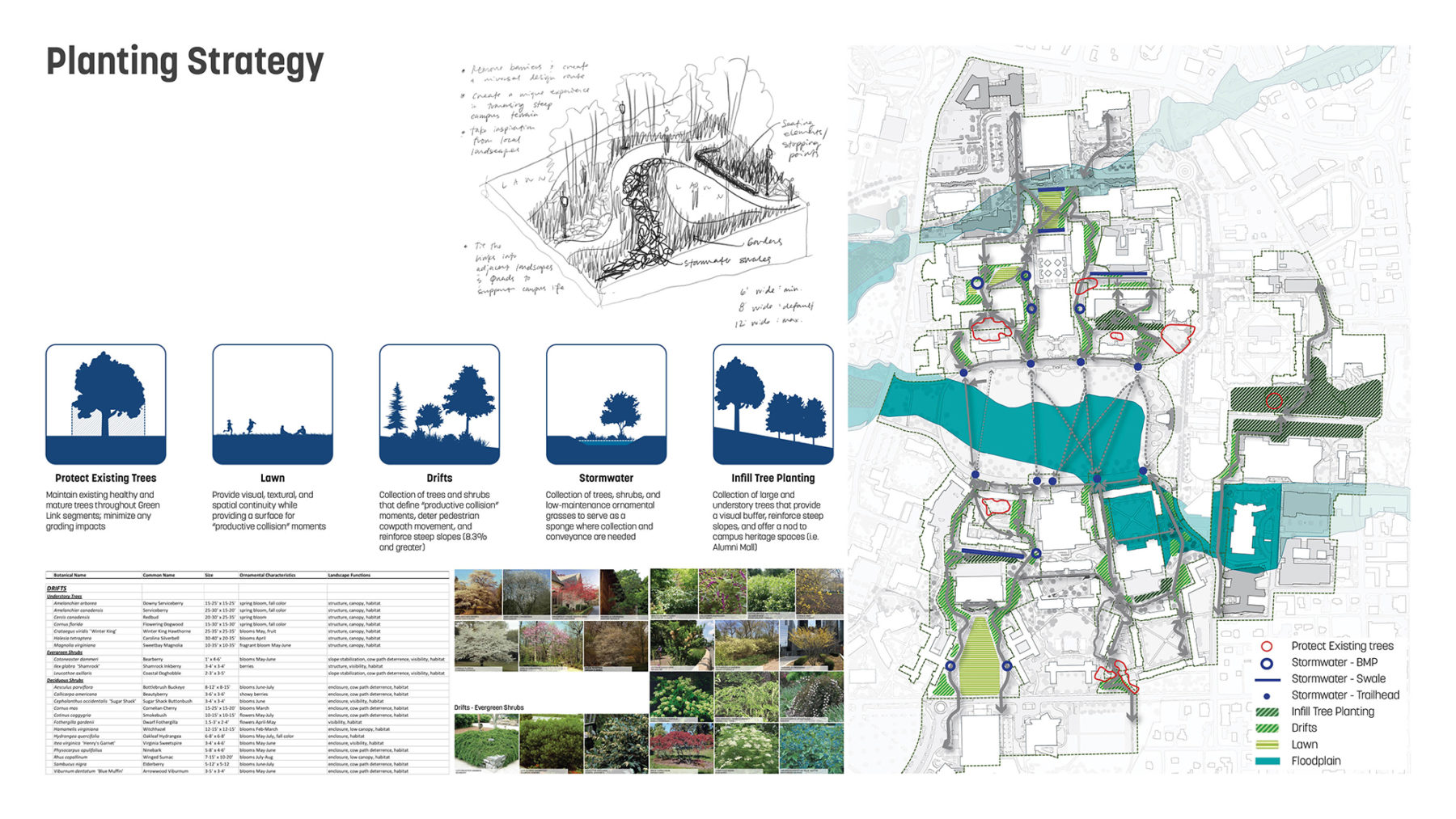
The planting palette encourages species diversity, working with native species
To achieve the goal of creating universally designed landscapes, each path must have its own accessibility strategy and typology that responds to local conditions. Detailed grading studies for each segment of the Infinite Loop and Green Links ensure a feasible and coordinated mobility network for over five miles of campus pathways. Over 400 stairs are removed from the existing campus and are replaced with ADA-compliant pathways (less than 5% slope). Where 5% is not practical or feasible, ramps no steeper than 8.3% slope are deployed. Path alignments are designed to be gently-curving, responding to desire lines and building entrances.
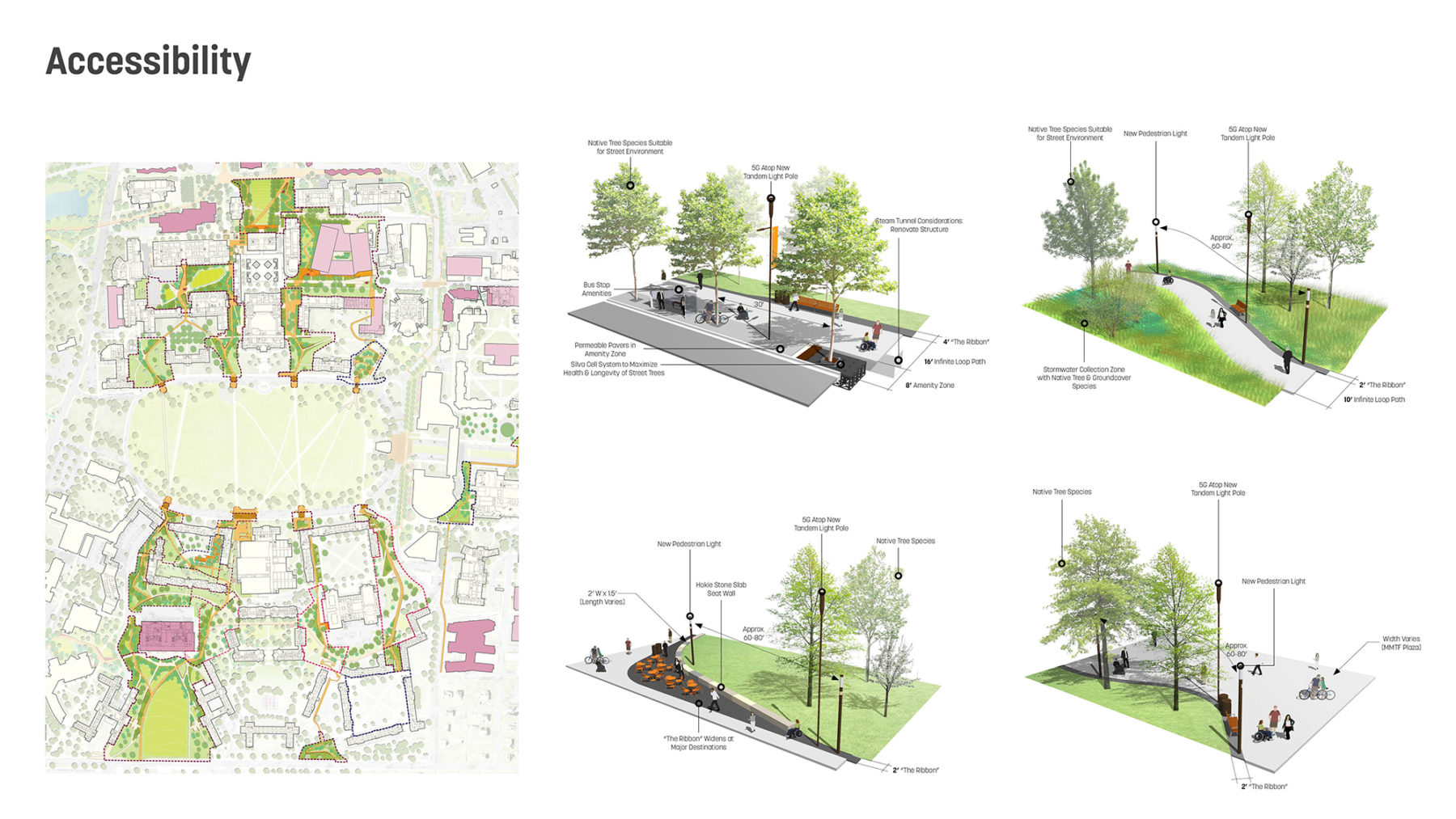
Grading studies ensure accessibility for over five miles of pathways
The Infinite Loop and the Green Links offer an attractive and desirable experience. They support campus life and its mission while also being highly contextual. New colors and textures enrich the campus landscape through a diverse palette of trees, shrubs, and groundcover. Lawns are purposefully placed, giving them importance while reducing mowing operations. A strategy of “Productive Collisions” creates opportunities for social interaction through furnishings and open spaces. This changes the landscape identity from one of pass through to one that prioritized stopping and resting – a critical feature of universal design – thus creating new destinations across campus.
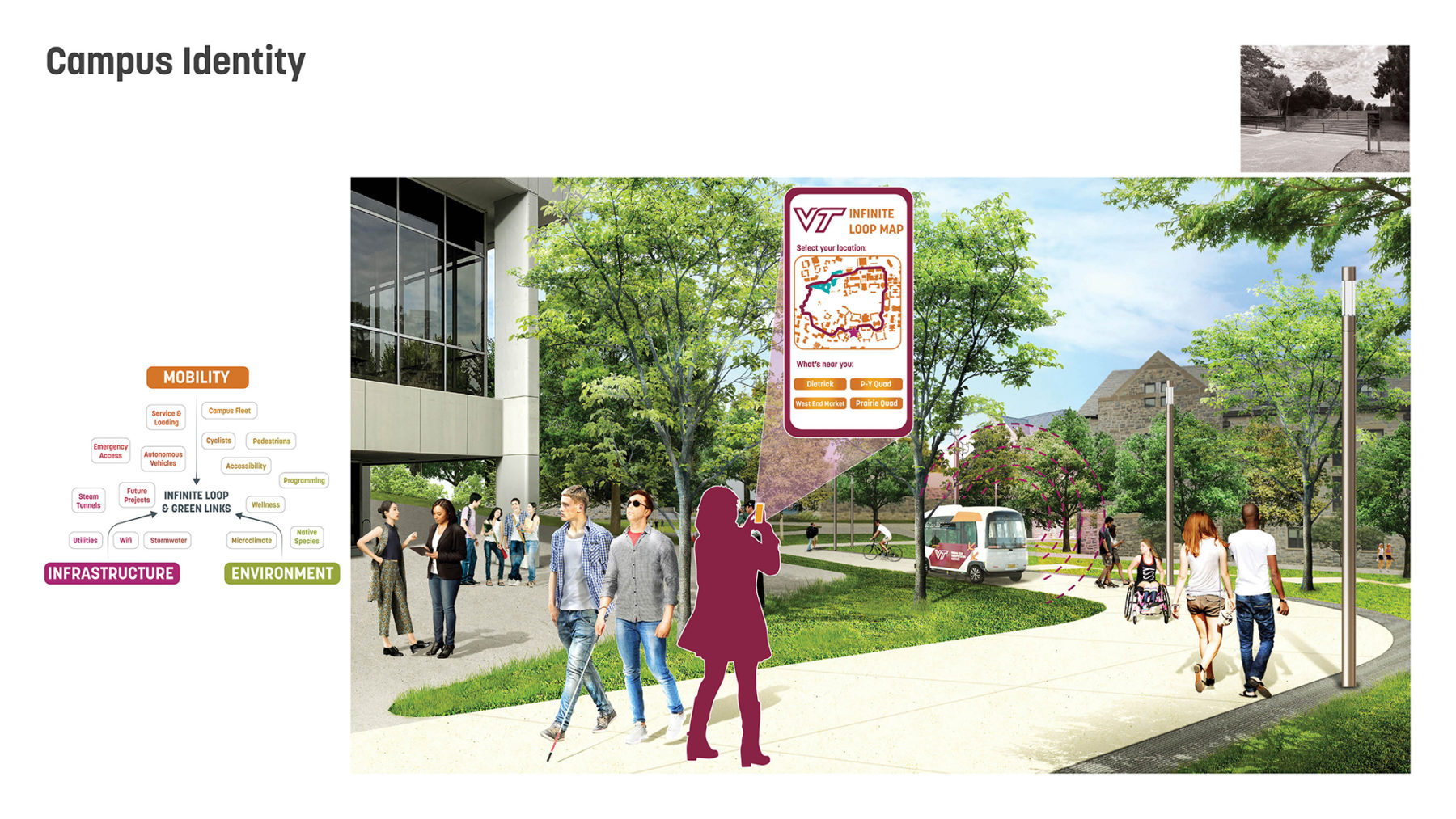
The design utilizes existing campus materials and adds elegant updates
The Infinite Loop and the Green Links find new ways to incorporate health and wellbeing into everyday activities for all members of the campus community. Walking, biking, or scootering are encouraged with new campus gateways and pathways that support these active modes of transportation to navigate campus. Furthermore, these pathways welcome people of all ages and abilities by embracing universal accessibility. In addition, outdoor classrooms, enhanced campus quads, and large natural areas like the enhanced Duck Pond landscape provide greater access to green spaces that can be used for working or relaxing outdoors, promoting mental health and wellbeing.
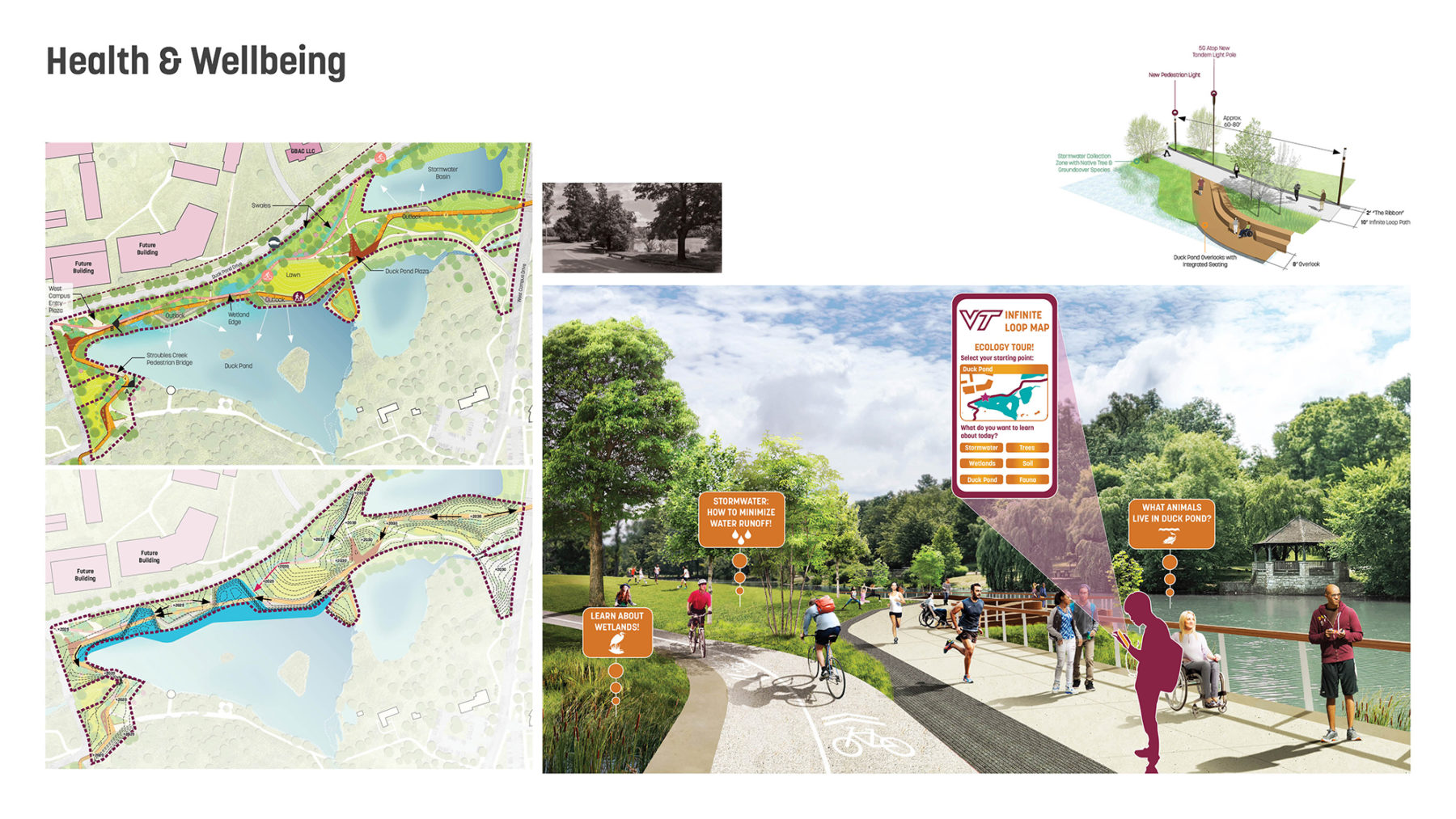
Physical and ecological health are cornerstones of the Duck Pond
A rigorous design process brought to light two specific programmatic and capital project synergies that allowed for an update of the master plan. Each of these areas – one in the existing campus core at a residential quad; one in a future campus district unencumbered by existing buildings – maintains master plan principles and overall desire lines while prioritizing and making feasible the Infinite Loop and Green Links grading strategies. These zoomed-in studies also consider existing and future utility enabling projects, including a chilled water line that will be built in the near-term and will require a new landscape to be built.
Integration of innovative technology along the Loop and the Green Links will keep students and faculty connected with new 5G across campus, extending the learning environment outdoors. Devices are spaced approximately 500’ along the Loop, ensuring a continuous cellular network that coincides with enhanced outdoor spaces including, quads, residential plazas, outdoor dining areas, and ecological corridors that are used for research. Outdoor power, blue phones, and campus security cameras are also provided. Additionally, the Infinite Loop is designed in partnership with the university’s transportation institute to accommodate autonomous vehicles, ushering in a new mode of transportation to the campus fabric.
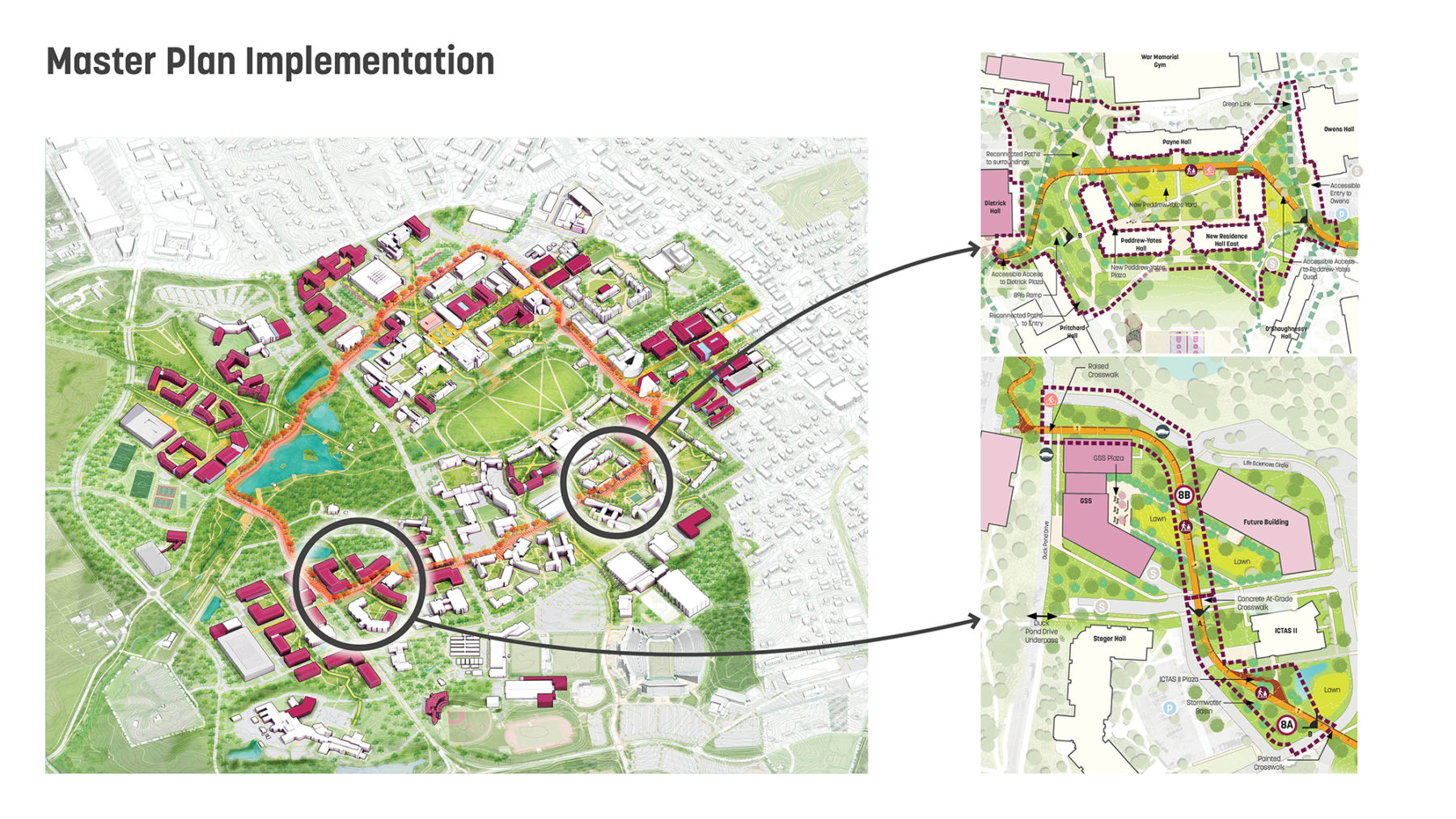
The design is responsive to updated university plans
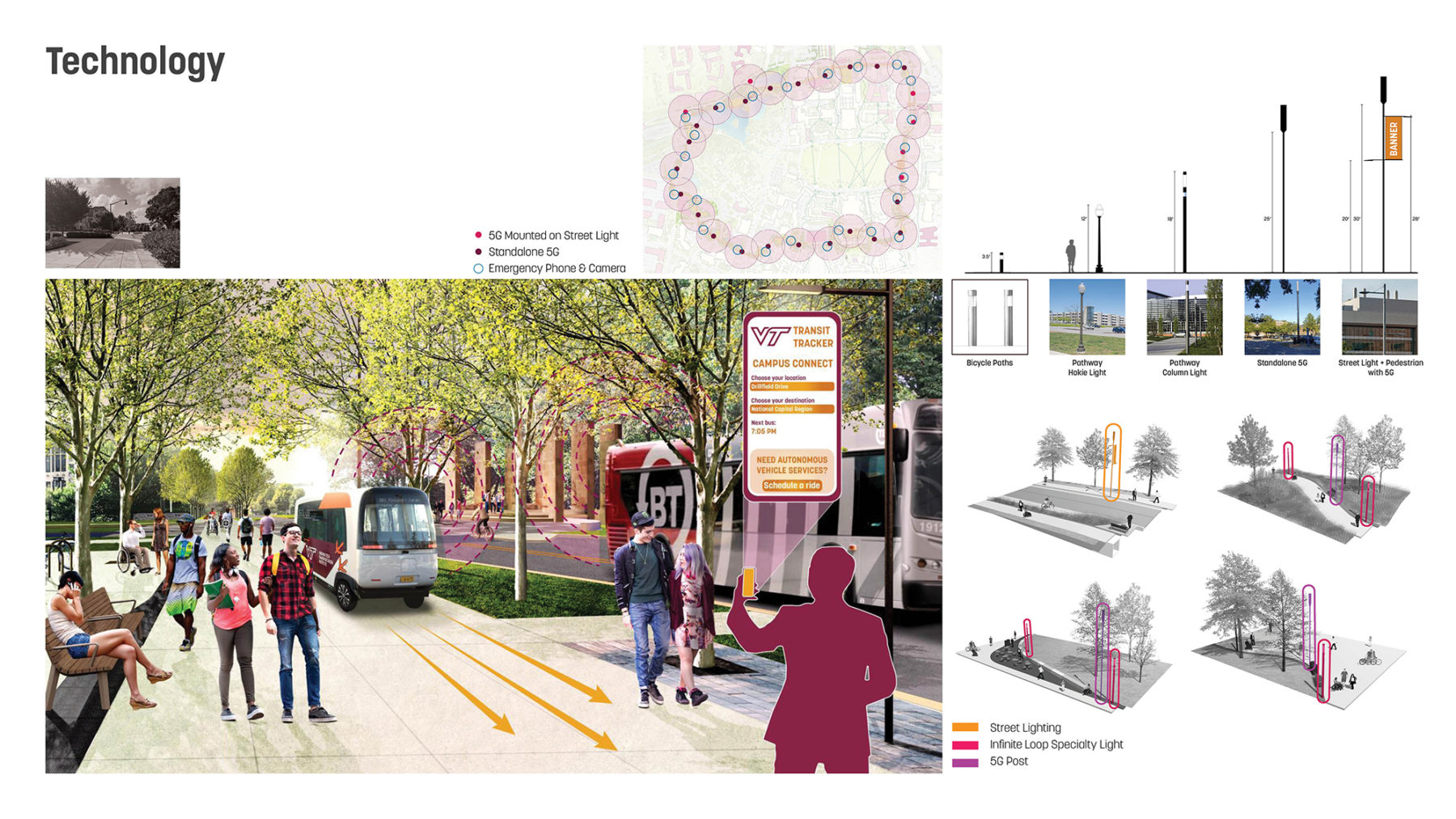
5G, autonomous vehicle routes, and new lighting are included
For more information contact Greg Havens.